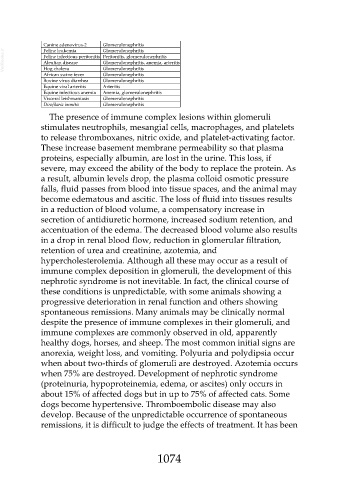Page 1074 - Veterinary Immunology, 10th Edition
P. 1074
Canine adenovirus-2 Glomerulonephritis
VetBooks.ir Feline infectious peritonitis Peritonitis, glomerulonephritis
Feline leukemia
Glomerulonephritis
Aleutian disease
Glomerulonephritis, anemia, arteritis
Hog cholera
African swine fever Glomerulonephritis
Glomerulonephritis
Bovine virus diarrhea Glomerulonephritis
Equine viral arteritis Arteritis
Equine infectious anemia Anemia, glomerulonephritis
Visceral leishmaniasis Glomerulonephritis
Dirofilaria immitis Glomerulonephritis
The presence of immune complex lesions within glomeruli
stimulates neutrophils, mesangial cells, macrophages, and platelets
to release thromboxanes, nitric oxide, and platelet-activating factor.
These increase basement membrane permeability so that plasma
proteins, especially albumin, are lost in the urine. This loss, if
severe, may exceed the ability of the body to replace the protein. As
a result, albumin levels drop, the plasma colloid osmotic pressure
falls, fluid passes from blood into tissue spaces, and the animal may
become edematous and ascitic. The loss of fluid into tissues results
in a reduction of blood volume, a compensatory increase in
secretion of antidiuretic hormone, increased sodium retention, and
accentuation of the edema. The decreased blood volume also results
in a drop in renal blood flow, reduction in glomerular filtration,
retention of urea and creatinine, azotemia, and
hypercholesterolemia. Although all these may occur as a result of
immune complex deposition in glomeruli, the development of this
nephrotic syndrome is not inevitable. In fact, the clinical course of
these conditions is unpredictable, with some animals showing a
progressive deterioration in renal function and others showing
spontaneous remissions. Many animals may be clinically normal
despite the presence of immune complexes in their glomeruli, and
immune complexes are commonly observed in old, apparently
healthy dogs, horses, and sheep. The most common initial signs are
anorexia, weight loss, and vomiting. Polyuria and polydipsia occur
when about two-thirds of glomeruli are destroyed. Azotemia occurs
when 75% are destroyed. Development of nephrotic syndrome
(proteinuria, hypoproteinemia, edema, or ascites) only occurs in
about 15% of affected dogs but in up to 75% of affected cats. Some
dogs become hypertensive. Thromboembolic disease may also
develop. Because of the unpredictable occurrence of spontaneous
remissions, it is difficult to judge the effects of treatment. It has been
1074

